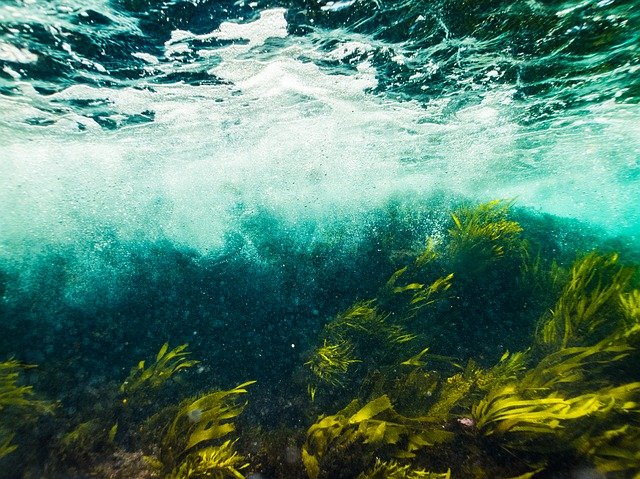Concern for single-use packaging and plastics in the oceans has skyrocketed in recent years as the consequences of our throwaway culture have become evident in all parts of the world. In fact, studies have shown that the American public is equally or even more concerned about oceanic plastic than climate change. Although the concept of bioplastics is appealing, sustainability concerns remain. One of these concerns is the impact of the inputs. For example, cultivating corn, a common input for bioplastics, impacts wildlife habitat, uses fossil fuels, and contaminates water.
But what if there were a sustainable packaging material made from something as natural and plentiful as seaweed?
Researching Seaweed in Packaging and Paper Products
DS Smith, a British multinational packaging company, is researching the use of seaweed in packaging and paper products. In particular, it is investigating whether seaweed could serve as an alternative material to wood or as a barrier coating in cartons, paper wraps, and cardboard trays. If successful, it would be the first to take this approach in the industry.

The company is researching “seaweed’s strength, resilience, recyclable properties, scalability, and cost,” says Giancarlo Maroto, managing director, paper, forestry, and recycling for DS Smith North America.
Seaweed could have multiple uses with a low ecological footprint that is easily recyclable and naturally biodegradable.” –Giancarlo Maroto, DS Smith North America.
The production process could use less energy and have fewer chemical inputs to extract fibers, says Maroto. Although this seems very promising, there is not yet enough information to evaluate seaweed packaging from a sustainability standpoint. Producers must have access to responsibly cultivated and harvested seaweed to manufacture the sustainable packaging solutions we need.
Growing Commercial Demand for Seaweed
Although some people may think of seaweed as just the slimy stuff on beaches, coastal people have consumed it since prehistoric times and the Japanese, Koreans, Chinese, and Native Americans have used it for centuries. Today, it is a common ingredient in personal care products, animal feed, and fertilizer. There is even research into using seaweed in biofuels.
As the commercial applications of seaweed increase, demand has skyrocketed, which has kept prices relatively high. In the process, the seaweed industry has created economic opportunities for coastal communities. Currently, most seaweed is cultivated and harvested in Asia, but as demand continues to grow, that trend is changing.
While some seaweed is wild-harvested, other types are farmed using buoys and lines. Although farmers can cultivate seaweed in a way that is regenerative and requires no fertilizer, freshwater, or feed inputs, this isn’t always the case. Unsustainable seaweed production processes could merely shift many of the environmental impacts of disposable packaging from land to the ocean, rather than eliminate them.
DS Smith’s Goal of 100% Recyclable Packaging
DS Smith has set a goal to manufacture 100% recyclable packaging within two years. The company wants to replace a billion pieces of supermarket and e-commerce plastic by 2025. Currently, the recycling industry is plagued with issues, especially regarding plastics. For example, only about 9% of all plastic produced has been recycled.
Plastic recycling has many challenges, including inconsistent demand for the recycled material, lack of recycling infrastructure, and the complexity of processing many different types of plastic. Ideally, seaweed packaging could help replace some of the plastic packaging currently on the market. It has the benefit of being naturally biodegradable and easily recyclable, according to DS Smith.
Research into seaweed in packaging and paper products is part of a $140 million investment by DS Smith into the circular economy over five years. It is also researching other alternative fibers, including straw, hemp, miscanthus, and agricultural waste, including cocoa shells and the pulp fiber remains after sugar cane processing.
Will Seaweed Meet the Need for Sustainable Packaging?
DS Smith has yet to release some critical details, such as what type of seaweed is ideal, where companies would source it, and if our existing recycling infrastructure can process seaweed packaging. Without basic information, it is difficult to compare a hypothetical product to existing packaging and paper products.
Although extremely convenient, disposable packaging is inherently wasteful because we use these materials for a very finite purpose. While reuse is higher on the waste reduction pyramid than recycling, disposable packaging is rarely reused. Yet, the concept of packaging from seaweed is promising, especially if there are end-of-life benefits such as being readily recyclable and biodegradable.
Researchers are also exploring the concept of infinitely recyclable plastic. Although it could be more expensive to produce, manufacturers could use the materials again and again. Hopefully, we will see major improvements in product packaging soon. This will give green-minded shoppers more options to make purchases that align with their values.








